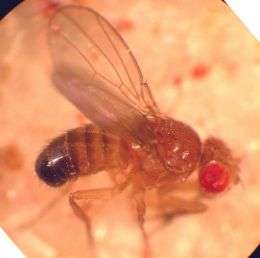Tiny fruit fly could offer big clues in fight against obesity

The tiny tongue of a fruit fly could provide big answers to questions about human eating habits, possibly even leading to new ways to treat obesity, according to a study from a team of Texas A&M University researchers.
Paul Hardin, who holds the rank of Distinguished Professor of Biology, along with colleagues Abhishek Chatterjee, Shintaro Tanoue and Jerry Houl, examined the taste organs on Drosophila's proboscis (tongue), which triggers the minute fruit fly's desire to eat or not to eat. They found that several factors, especially the creature's internal daily clock, determine feeding behaviors - and these same taste sensitivities very likely apply to humans.
Their work is published in the new issue of the journal Current Biology.
"The 'clock' that influences this decision to eat or not to eat is found inside the taste sensing cells, which send a signal to eat," Hardin explains.
"Once this signal is sent, the brain then tells the fly to eat or not, but all of this seems to depend on the time of day. These clocks have a very direct link to its eating habits."
Drosophila, commonly called fruit flies and smaller than a grain of rice, are found worldwide and there about 1,500 species. The word is a Latin phrase for "dew loving."
Like most flies, they have a natural instinct to seek out food "and they are always looking for something to eat," Hardin adds.
"These inner clocks control the sensitivity to food and also affect how much the flies eat. We found that the highest sensitivity to sugar is in the daytime, and far less at night. But we found that if you eliminate these clocks, the flies will eat much more food. So these clocks seem to suppress the desire for food at certain times of day."
Hardin notes that there are obvious parallels that could be drawn comparing the desire for food by the fruit flies and the human desire for food.
"It's long been established that as humans, we have clocks, too," he adds.
"If clocks in our taste-sensing cells also control when and how much we eat, it could greatly impact weight gain. Understanding how these clocks control eating could potentially lead to ways to combat obesity."
Obesity is one of the major threats to health worldwide, especially in the United States, where the number of obese persons has skyrocketed in recent years.
According to the American Medical Association, about one-third of all Americans are now classified as being obese, and obesity rates have soared 60 percent in the last 20 years. Obesity leads to a number of ailments, including heart attacks, strokes, certain cancers, diabetes and others. About 33 percent of all U.S. children are considered overweight or obese, a figure that has risen steadily in recent years, and in an average year, there are more than 300,000-obesity related deaths in the U.S.
"By looking closely at factors that control Drosophila's desire to eat, we can draw comparisons to human eating behaviors," Hardin says.
Provided by Texas A&M University















